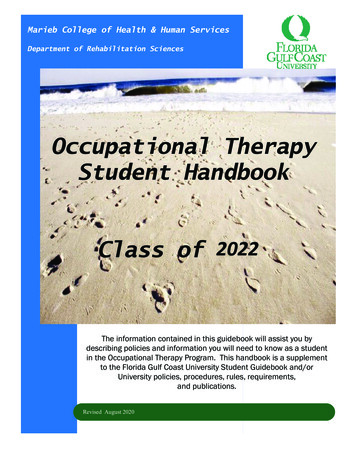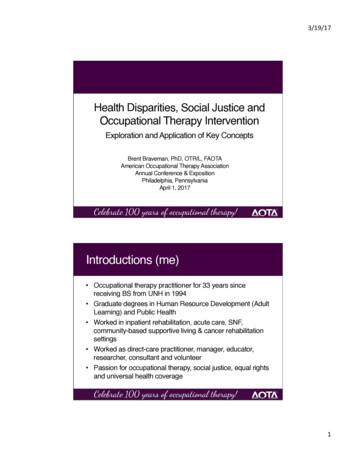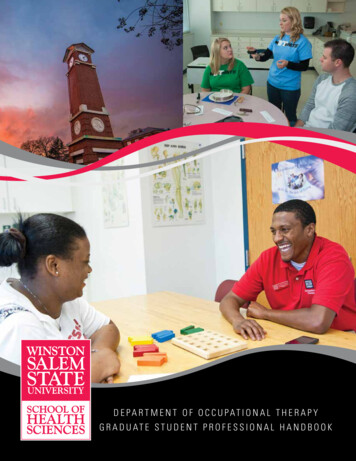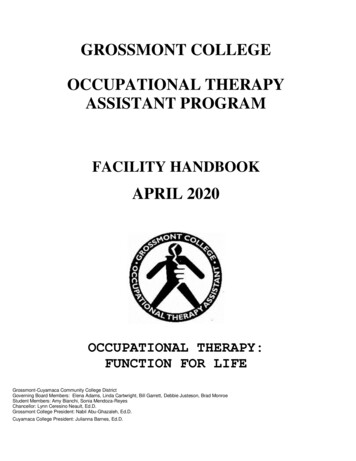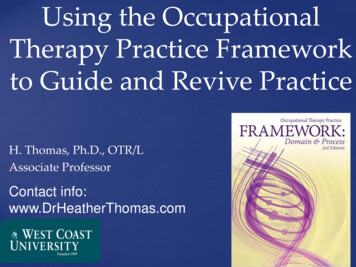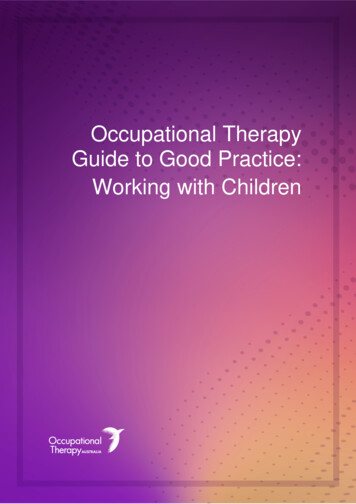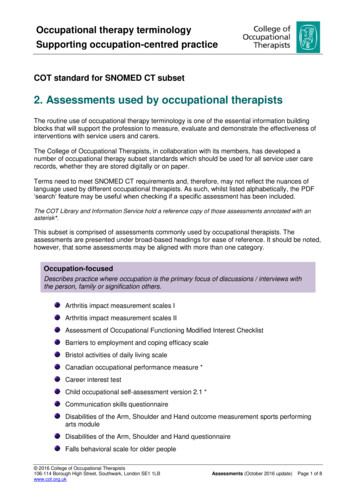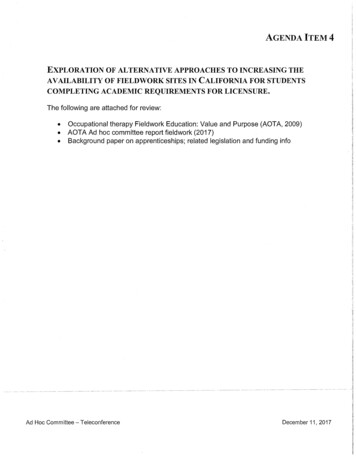
Transcription
Occupational Therapy ToolkitTreatment Guides - Section 1ADLs and IADLsActivities of Daily LivingBathing and ShoweringClothing CareCommunity MobilityDressingDrivingFeeding, Eating, and SwallowingFinancial and Mail ManagementFunctional CommunicationFunctional MobilityGrooming and Oral HygieneHealth ManagementHome and Yard MaintenanceLeisure and Social ActivitiesMeal PreparationMedication ManagementRest and SleepSexual Expression and ceCognitionFall Risk Assessment and PreventionHandwritingHome Safety and ModificationTherapeutic ExerciseVisual PerceptionConditions and DiseasesAction TremorAdhesive CapsulitisAlzheimer’s Disease and Related Dementias - Early StageAlzheimer’s Disease and Related Dementias - Mid StageAlzheimer’s Disease and Related Dementias - Late StageAmputation of the Lower LimbAmputation of the Upper LimbAmyotrophic Lateral SclerosisAnkylosing SpondylitisBiceps TendinitisBreast Cancer - Pre and Postoperative Management 2018 Cheryl Hall www.ottoolkit.com
Occupational Therapy ToolkitTreatment Guides - Section 1Conditions and DiseasesBurn InjuryCancerCardiac DiseaseCardiac SurgeryCarpal Tunnel Syndrome - Conservative ManagementCarpal Tunnel Syndrome - Postoperative ManagementCervical Stenosis, Myelopathy, and RadiculopathyCervical Spine SurgeryChronic Obstructive Pulmonary DiseaseChronic/Persistent Pain SyndromeComplex Regional Pain Syndrome Type ICongestive Heart Failure (see Cardiac Disease)Cubital Tunnel Syndrome - Conservative ManagementCubital Tunnel Syndrome - Postoperative ManagementDepressionDe Quervain's Syndrome - Conservative ManagementDe Quervain's Syndrome - Postoperative ManagementDiabetes - Type 2DizzinessEmphysema (see Chronic Obstructive Pulmonary Disease)Epicondylitis - Conservative ManagementFibromyalgia (see Chronic/Persistent Pain Syndrome)Fracture of the Elbow (Radial Head/Olecranon/Distal Humerus)Fracture of the Hip (Proximal Femur)Fracture of the Shoulder (Proximal Humerus)Fracture of the Wrist (Distal Radius)Frailty and DebilityGeneralized Anxiety DisorderGuillain-Barré SyndromeHuntington's DiseaseJoint ContracturesKidney DiseaseLow Back Pain (see Chronic/Persistent Pain Syndrome)Low Vision and BlindnessLumbar StenosisLumbar Spine SurgeryMild Cognitive ImpairmentMorbid Obesity - Person of SizeMultiple SclerosisMyasthenia Gravis - GeneralizedMyocardial Infarction 2018 Cheryl Hall www.ottoolkit.com
Occupational Therapy ToolkitTreatment Guides - Section 1Conditions and DiseasesOsteoarthritis - Conservative ManagementOsteoporosisPalliative Care and HospiceParkinson's Disease - Early StageParkinson's Disease - Mid StageParkinson's Disease - Late StagePeripheral NeuropathyPost-Poliomyelitis SyndromePressure UlcersRheumatoid Arthritis - Conservative ManagementRotator Cuff Pathology - Conservative ManagementRotator Cuff Pathology - Postoperative ManagementScleroderma/Systemic SclerosisSpinal Cord Injury - Paraplegia T1-S5Spinal Cord Injury - Tetraplegia/Quadriplegia C1-8StrokeTotal Hip Replacement (Arthoplasty)Total Knee Replacement (Arthoplasty)Total Shoulder Replacement (Arthoplasty)Urinary IncontinenceVertebral Compression Fracture 2018 Cheryl Hall www.ottoolkit.com
Occupational Therapy ToolkitADL and Mobility Handouts - Section 2Adaptive EquipmentAdaptive Equipment for BathingAdaptive Equipment for DressingAdaptive Equipment for EatingAdaptive Equipment for Grooming and Mouth CareAdaptive Equipment for Meal PrepAdaptive Equipment for MobilityAdaptive Equipment for Moving in BedAdaptive Equipment for TransfersAdaptive Equipment for Using the BathroomAdaptive Equipment for WalkingAmbulationWalk with a Cane on the Stronger, Left SideWalk with a Cane on the Stronger, Right SideWalk with a Standard Walker - Full Weight BearingWalk with a Standard Walker - Non-Weight BearingWalk with a Standard Walker - Partial Weight BearingWalk with a Standard Walker - Toe-Touch Weight BearingWalk with a Standard Walker - Weight Bearing as ToleratedWalk with a Wheeled Walker - Full Weight BearingWalk with a Wheeled Walker - Weight Bearing as ToleratedBathing and ShoweringBathing TipsHow to Install Grab Bars - LeftHow to Install Grab Bars - RightBath TransfersTransfer to Shower Chair (back up, turn left)Transfer to Shower Chair (back up, turn right)Transfer to Shower Chair (left leg, right leg, sit)Transfer to Shower Chair (right leg, left leg, sit)Transfer to Shower Chair (left leg, sit, right leg)Transfer to Shower Chair (right leg, sit, left leg)Transfer to Tub Bench - After Hip Surgery (back up, turn left)Transfer to Tub Bench - After Hip Surgery (back up, turn right)Transfer to Tub Bench (back up, turn left)Transfer to Tub Bench (back up, turn right)Transfer Wheelchair to Tub Bench - Move to the LeftTransfer Wheelchair to Tub Bench - Move to the RightBed MobilityBridgingIn and Out of Bed - Toward Your Left SideIn and Out of Bed - Toward Your Right Side 2018 Cheryl Hall www.ottoolkit.com
Occupational Therapy ToolkitADL and Mobility Handouts - Section 2Bed MobilityIn and Out of Bed - Toward Your Left Side After Hip SurgeryIn and Out of Bed - Toward Your Right Side After Hip SurgeryIn and Out of Bed - Toward Your Left Side Log RollingIn and Out of Bed - Toward Your Right Side Log RollingIn and Out of Bed - Toward Your Weaker Left SideIn and Out of Bed - Toward Your Weaker Right SideIn and Out of Bed with Help - Toward Their Left SideIn and Out of Bed with Help - Toward Their Right SideMove From One Side 0f the Bed to the OtherMove Up in BedRoll onto Your Left SideRoll onto Your Right SideDressingDressing TipsPut On and Take Off a T-shirt - Arm-Head-ArmPut On and Take Off a T-shirt - Head-Arm-ArmPut On and Take Off a T-shirt Using a Dressing StickPut On and Take Off an Ankle-Foot Brace - Method 1 - Left LegPut On and Take Off an Ankle-Foot Brace - Method 1 - Right LegPut On and Take Off an Ankle-Foot Brace - Method 2 - Left LegPut On and Take Off an Ankle-Foot Brace - Method 2 - Right LegPut On and Take Off an Open Front Shirt - One Shoulder DrapePut On and Take Off an Open Front Shirt - Two Shoulder DrapePut On and Take Off an Open Front Shirt Using a Dressing StickPut On and Take Off Pants - Method 1Put On and Take Off Pants - Method 2Put On and Take Off Pants, Socks, and Shoes Lying DownPut On and Take Off Pants, Socks, and Shoes Using a StoolPut On and Take Off Pants Using a Dressing Stick or ReacherPut On and Take Off Socks and Shoes Using Dressing ToolsPut On and Take Off Support StockingsUsing a ButtonhookDressing with One HandPut On a T-shirt with One Hand - Left Side WeaknessPut On a T-shirt with One Hand - Right Side WeaknessPut On an Open Front Shirt with One Hand - Left Side WeaknessPut On an Open Front Shirt with One Hand - Right Side WeaknessPut On and Take Off a Bra with One Hand - Left Side WeaknessPut On and Take Off a Bra with One Hand - Right Side WeaknessPut On Pants with One Hand - Left Side WeaknessPut On Pants with One Hand - Right Side Weakness 2018 Cheryl Hall www.ottoolkit.com
Occupational Therapy ToolkitADL and Mobility Handouts - Section 2Dressing with One HandPut On Socks and Shoes with One Hand - Left Side WeaknessPut On Socks and Shoes with One Hand - Right Side WeaknessTake Off a T-shirt with One Hand - Left Side WeaknessTake Off a T-shirt with One Hand - Right Side WeaknessTake Off an Open Front Shirt One Hand - Left Side WeaknessTake Off an Open Front Shirt One Hand - Right Side WeaknessTake Off Pants with One Hand - Left Side WeaknessTake Off Pants with One Hand - Right Side WeaknessTie Shoes with One Hand - Left Side WeaknessTie Shoes with One Hand - Right Side WeaknessHealth ManagementHealth Care TeamTips for Making and Keeping Health Care VisitsMeal Prep and Clean UpManage Kitchen Tasks with a WalkerManage Kitchen Tasks with a WheelchairMeal Prep with One HandStairsDown a Curb or Single Step Using a WalkerDown Steps with a Rail Using a CaneDown Steps with a Rail Using a Closed WalkerDown Steps with a Rail Using an Open WalkerDown Steps without a Rail Using a CaneUp a Curb or Single Step Using a WalkerUp Steps with a Rail Using a CaneUp Steps with a Rail Using a Closed WalkerUp Steps with a Rail Using an Open WalkerUp Steps without a Rail Using a CaneToiletingTips for Using the BathroomToileting Options - Therapist ResourceTransfersCar TransferGet Down On the FloorGet Up From the FloorSit-Pivot Transfer - Move to the LeftSit-Pivot Transfer - Move to the RightSit-Pivot Transfer with Help - Move to Their LeftSit-Pivot Transfer with Help - Move to Their RightSitting DownSitting Down - After Hip Surgery 2018 Cheryl Hall www.ottoolkit.com
Occupational Therapy ToolkitADL and Mobility Handouts - Section 2TransfersStanding UpStanding Up - After Hip SurgeryStanding Up with HelpStand-Pivot Transfer with Help - Move to Their LeftStand-Pivot Transfer with Help - Move to Their RightTransfer Board - Move to the LeftTransfer Board - Move to the RightWheelchair MobilityWheelchair Mobility 2018 Cheryl Hall www.ottoolkit.com
Occupational Therapy ToolkitEducational Handouts - Section 3AmputationCare of the Prosthesis and Lower Limb CoveringsCare of the Prosthesis and Upper Limb CoveringsCare of Your Residual LimbPhantom Limb PainPosition Your Residual Limb - AKAPosition Your Residual Limb - BKACardiopulmonaryBreathing Distress - Causes and Tips to PreventBreathing Distress ControlCardiac Precautions for Exercise - Therapist ResourceControlled CoughDaily Tasks after Open Heart SurgeryDeep (Diaphragmatic) BreathingFatigue JournalHow to Check Your Heart RatePostural Drainage PositionsPursed Lip BreathingSternal (Breastbone) PrecautionsTips to Conserve EnergyTips to Conserve Energy with Meal and Home ManagementTips to Conserve Energy with Self Care ActivitiesCognition and Visual PerceptionDaily JournalFunctional Cognitive Activities - Therapist ResourceTips to Improve AttentionTips to Improve Figure GroundTips to Improve Form ConstancyTips to Improve Left Side AwarenessTips to Improve MemoryTips to Improve Memory - External Memory AidsTips to Improve Memory - Internal Memory AidsTips to Improve Motor-PlanningTips to Improve Right Side AwarenessTips to Improve Thinking SkillsTips to Improve VisionTips to Improve Visual-Motor IntegrationTips to Improve Visual Spatial RelationsLow VisionEatingFunctional Reading - Therapist ResourceFunctional Vision - Therapist Resource 2018 Cheryl Hall www.ottoolkit.com
Occupational Therapy ToolkitEducational Handouts - Section 3Low VisionImprove Your Other SensesKitchen TasksLabel and Mark ItemsLeisureLightingMedicationMoneyMoving AroundReading, Writing, Phone UseReduce GlareSafetyUse ContrastNeurologicalCognitive Strategies to Improve MovementHandwriting - Component ExercisesHandwriting - Cursive ExercisesHandwriting - PangramsPosition in Bed - Left Side WeaknessPosition in Bed - Right Side WeaknessPosition Your Arm - Left Side WeaknessPosition Your Arm - Right Side WeaknessProtect the Arm - Left Side WeaknessProtect the Arm - Right Side WeaknessTips to Manage Action TremorsWriting Tips for Parkinson’sOtherAnxiety JournalArm MeasurementChecking Your SkinGood Sleep HabitsLeg MeasurementLeisure ActivitiesPain JournalPosition in Bed to Reduce PressurePressure ReliefSMART GoalsSMART Goals - Action PlanStress ManagementStress Management - Relaxation ToolsStress Management - Stress JournalTips to Prevent Lower Body Lymphedema 2018 Cheryl Hall www.ottoolkit.com
Occupational Therapy ToolkitEducational Handouts - Section 3OtherTips to Prevent Upper Body LymphedemaOrthopedicArthritic Joint Changes and Deformities - Therapist ResourceBody MechanicsDaily Tasks after Back (Lumbar) SurgeryDaily Tasks after Neck (Cervical) SurgeryDaily Tasks after Shoulder SurgeryDesensitizationEdema (Swelling) Control of the Arm(s)Edema (Swelling) Control of the Leg(s)Good PostureHip Dislocation Precautions - Posterior ApproachJoint Protection and Energy Conservation for Wheelchair UsersJoint Protection for ArthritisScar MassageSpinal Surgery PrecautionsSplint/Brace InstructionsSuperficial ColdSuperficial HeatSafetyDon’t Let a Fall Get You Down - BookletDon’t Let a Fall Get You Down - Post-Fall SurveyFall Triggers and Tips to Prevent Falls - Therapist ResourceFoot Care and Foot SafetyHome Safety and Performance Assessment - Therapist ResourceUsing a Front Wheel Walker (2 wheels)Using a Rollator (3 or 4 wheels)Using a Standard Walker (no wheels)Using a Wheelchair 2018 Cheryl Hall www.ottoolkit.com
Occupational Therapy ToolkitTherapeutic Exercise Handouts - Section 4BalanceBalance Exercise GuidelinesBalance Exercises - SittingBalance Exercises - StandingCore Exercise GuidelinesCore Exercises - Back MusclesCore Exercises - Pelvic MusclesCore Exercises - Stomach MusclesExercise Ball GuidelinesExercise Ball - Back MusclesExercise Ball - Pelvic MusclesExercise Ball - Stomach MusclesCondition SpecificBurn Injury Stretches - GuidelinesBurn Injury Stretches - FaceBurn Injury Stretches - NeckBurn Injury Stretches - TrunkBurn Injury Stretches - ShoulderBurn Injury Stretches - Elbow, Forearm, WristBurn Injury Stretches - Left HandBurn Injury Stretches - Right HandBurn Injury Stretches - Hip and KneeBurn Injury Stretches - Ankle and ToesElbow Stretches for Below Elbow AmputationExercise Tips for Amyotrophic Lateral SclerosisExercise Tips for ArthritisExercise Tips for DiabetesExercise Tips for Guillain-Barré SyndromeExercise Tips for Multiple SclerosisExercise Tips for Myasthenia GravisExercise Tips for Orthopedic ConditionsExercise Tips for Post-Poliomyelitis SyndromeExercise Tips for Renal ConditionsMastectomy ExercisesOsteoporosis Extension ExercisesParkinson’s Disease ExercisesPulmonary ExercisesElbow, Forearm, WristElbow, Forearm and Wrist Active Range of MotionElbow, Forearm and Wrist Strength ExercisesElbow, Forearm and Wrist StretchesElbow, Wrist and Hand Active Exercises 2018 Cheryl Hall www.ottoolkit.com
Occupational Therapy ToolkitTherapeutic Exercise Handouts - Section 4Elbow, Forearm, WristForearm and Wrist Active Range of MotionForearm and Wrist Strength ExercisesForearm and Wrist StretchesHandFine Motor ActivitiesFinger and Thumb Strength Exercises - LeftFinger and Thumb Strength Exercises - RightFinger and Thumb Stretches and Active Range of Motion - LeftFinger and Thumb Stretches and Active Range of Motion - RightFlexor Tendon GlidesMedian Nerve GlidesPutty ExercisesLower BodyAnkle and Foot Active Range of MotionAnkle and Foot Isometric ExercisesAnkle and Foot Strength ExercisesAnkle and Foot StretchesHip and Knee Exercises - LyingHip and Knee Exercises - SeatedHip and Knee Exercises - StandingLow Back StretchesStretch Band Exercises - LegsThigh StretchesMiscellaneousFace and Neck Active Range of MotionGeneral Exercise TipsPassive Range of MotionPelvic Floor (Kegel) ExercisePhysical Activity PlanWalking GuidelinesNeckNeck Active Range of MotionNeck Isometric ExercisesNeck Strength ExercisesNeck StretchesShoulderDowel Exercises - SupineDowel Exercises - UprightPendulum Exercises - LeftPendulum Exercises - RightShoulder Active Range of Motion 2018 Cheryl Hall www.ottoolkit.com
Occupational Therapy ToolkitTherapeutic Exercise Handouts - Section 4ShoulderShoulder and Hand Active ExercisesShoulder and Rotator Cuff Active Exercises - LeftShoulder and Rotator Cuff Active Exercises - RightShoulder and Rotator Cuff Exercises Free Weight - LeftShoulder and Rotator Cuff Exercises Free Weight - RightShoulder and Rotator Cuff Exercises Stretch Band - LeftShoulder and Rotator Cuff Exercises Stretch Band - RightShoulder Blade ExercisesShoulder, Elbow, and Hand Active ExercisesShoulder Isometric Left - SeatedShoulder Isometric Left - StandingShoulder Isometric Right - SeatedShoulder Isometric Right - StandingShoulder Passive and Active-Assisted Range of Motion - LeftShoulder Passive and Active-Assisted Range of Motion - RightShoulder Pulley Exercises - LeftShoulder Pulley Exercises - RightShoulder Stretches - LeftShoulder Stretches - RightStrokeLevel 1 Activities - Help Your Weaker Arm MoveLevel 2 Activities - Use Your Weaker Arm to Passively HoldLevel 3 Activities - Use Your Weaker Arm to Actively Move & HoldLevel 4 Activities - Use Your Weaker Arm with Gross MotorLevel 5 Activities - Use Your Weaker Arm with Fine MotorPassive Range of Motion - Left Side WeaknessPassive Range of Motion - Right Side WeaknessScapular Mobility and Strength Exercises - Left Side WeaknessScapular Mobility and Strength Exercises - Right Side WeaknessSelf Range of Motion - Left Side WeaknessSelf Range of Motion - Right Side WeaknessUse Your Left Arm to Actively Move and HoldUse Your Left Arm to Passively HoldUse Your Left Arm with Assisted GuidingUse Your Left Arm with Gross Motor ActivitiesUse Your Left Arm with Self-GuidingUse Your Right Arm to Actively Move and HoldUse Your Right Arm to Passively HoldUse Your Right Arm with Assisted GuidingUse Your Right Arm with Gross Motor ActivitiesUse Your Right Arm with Self-Guiding 2018 Cheryl Hall www.ottoolkit.com
Occupational Therapy ToolkitTherapeutic Exercise Handouts - Section 4StrokeWeight Bearing Exercises - Left Side WeaknessWeight Bearing Exercises - Right Side WeaknessUpper BodyArm CycleCool-Down StretchesGross Motor TasksNerve Flossing - MedianNerve Flossing - RadialNerve Flossing - UlnarPosture ExercisesStretch Band Exercises - ArmsUpper Body Active Range of MotionUpper Body Exercises - Hand WeightsUpper Body Exercises - Using a BallUpper Body Strength ActivitiesWarm-Up Exercises 2018 Cheryl Hall www.ottoolkit.com
Occupational Therapy ToolkitBreast Cancer - Pre and Postoperative ManagementSurgical procedures include radical, modified or simple mastectomies, lymph nodedissection, and breast reconstruction.Impairments and Functional Limitations:ADL, IADL, productivity and leisure impairmentImpaired ROM and strength of trunk and upper extremityPost-op pain and edemaPotential secondary complications - nerve damage, lymphedemaOccupational Therapy Preoperative Intervention: Baseline measurements (ROM, strength, sensation, and limb measurements) Provide education about post-operative activity limitations, precautions andexercise. Instruct in good posture during activities. Educate about lymphedema prevention or risk factor reduction. Teach strategies to incorporate wellness and health management routines intodaily activities. Educate about breast cancer and the availability of community resources.Encourage participation in support groups.Occupational Therapy Postoperative Intervention:ADL, IADL, productivity and leisure training Treat underlying limitations to safety and independence. Recommend and/or provide adaptive equipment as needed. Train in lower bodyADL equipment following reconstructive surgery involving abdominal muscles. Instruct in good posture during activities. Instruct in protective use of affected arm for the first 2 weeks. Avoid overuse,avoid sleeping on the same side as the surgery, avoid lifting more than 5 pounds,keep tasks below 90-degrees of shoulder motion. Instruct to elevate arm severaltimes a day to manage post-op edema. Unless otherwise instructed by surgeon.Train in safe and efficient functional mobility (sit to stand, bed mobility skills, transfers,ambulation and wheelchair mobility) during ADL and IADL tasks.Pain self-management Coordinate medication peak with exercise and activity. Teach stress management and relaxation techniques. Use pillows to help arm and shoulder relax in sitting and lying down. Instruct in good posture during activities. 2018 Cheryl Hall www.ottoolkit.com
Occupational Therapy ToolkitBreast Cancer - Pre and Postoperative ManagementOccupational Therapy Postoperative Intervention:Provide graded UE activities and exercises. Follow the referring surgeon’s specificguidelines for ROM and progression of exercises. AROM exercises starting 2-3 days after surgery. Progress exercises until full ROMrestored. Begin strengthening 4-6 weeks after surgery. Instruct in deep (diaphragmatic) breathing exercises and lateral expansion. Instruct in a walking program.Provide surgical scar management at 3-4 weeks post surgery (mobilization, massage,desensitization, stretching exercises).Provide education about lymphedema prevention and risk factor reduction.Patient and Caregiver Handouts:Arm MeasurementDeep (Diaphragmatic) BreathingEdema (Swelling) Control of the Arm(s)Good PostureMastectomy ExercisesScar MassageTips to Prevent Lower Body LymphedemaWalking GuidelinesAdditional Treatment Guides:CancerHealth Management 2018 Cheryl Hall www.ottoolkit.com
Occupational Therapy ToolkitDressingDressing includes selecting appropriate clothing for the time of day, weather, andoccasion. Obtain clothing from closets and drawers. Dress and undress using open-frontgarments (shirt/blouse, robe, sweater, jacket, winter coat), pullover garments(sweatshirt, t-shirt, sweater), bra, pants, skirts, suspenders, necktie, scarf, gloves,underwear, socks, pantyhose, nylons, shoes, boots, slippers, support and anti-embolismstockings. Open and close fasteners, (snaps, buttons, hooks, zippers, Velcro). Managingpersonal devices (hearing aids, eyeglasses, contacts, AFO, hand splint, back brace,slings, and prosthetics).Impairments and Functional Limitations:Impaired shoulder strength and/or ROMImpaired hand strength, ROM, sensation and/or coordinationImpaired LE functionLimited activity tolerance and enduranceImpaired sitting balanceImpaired standing balancePainVisual perceptual impairmentCognitive impairmentOccupational Therapy Intervention:Apply different approaches for solving difficulties with dressing. Remediate underlying limitations to safety and independence. Physicalimpairments (muscle weakness, impaired hand function, limited ROM, paralysis,incoordination, impaired balance, fatigue, dyspnea, abnormal tone, tremor),sensory impairment (impaired sensation, low vision, hard of hearing, vestibular,pain), behavioral, cognition, perception. Train in compensatory techniques (safety techniques, one-handed techniques,pacing, energy conservation, joint protection, body mechanics, breathingtechniques, low vision techniques, cognitive/perceptual compensation, step-bystep instructions, task segmentation, task sequencing, backward chaining, verbaland physical cueing, hand-over-hand guiding). Train in the use of adaptive equipment and assistive devices (buttonhook, Velcroclosures on shoes, elastic shoelaces, long handled shoehorn, dressing stick,reacher, sock aid, zipper pull, loops on pants, loops on socks, labeling system foridentifying clothes, and specialized clothing). Provide environmental modifications and adaptations (avoid storing items on thefloor, lower closet poles, organize clothes within easy reach, and label drawersusing picture or words). 2018 Cheryl Hall www.ottoolkit.com
Occupational Therapy ToolkitDressingOccupational Therapy Intervention:Apply different approaches for solving difficulties with dressing (continued). Instruct in activity modification.o Change the task (place the weaker extremity into the garment first, dressin a supine position).o Eliminate part or all of the task (choose garments that are easy to put onand remove such as: elastic waist pants, loose fitting tops, pullovertops, suspenders instead of a belt, Velcro shoes, slip on shoes, front hookbra, sports bra, camisole).o Have someone else do part or the entire task.Train in safe and efficient functional mobility (sit to stand, bed mobility skills, transfers,standing, ambulation, and wheelchair mobility) during dressing tasks.Provide caregiver/family education and training.Patient and Caregiver Handouts:Adaptive Equipment for DressingDressing TipsTips to Conserve Energy with Self Care TasksDressing Techniques - Lower BodyPut On and Take Off an Ankle-Foot Brace - Method 1 - Left LegPut On and Take Off an Ankle-Foot Brace - Method 1 - Right LegPut On and Take Off an Ankle-Foot Brace - Method 2 - Left LegPut On and Take Off an Ankle-Foot Brace - Method 2 - Right LegPut On and Take Off Pants - Method 1Put On and Take Off Pants - Method 2Put On and Take Off Pants, Socks, and Shoes Lying DownPut On and Take Off Pants, Socks, and Shoes Using a StoolPut On and Take Off Pants Using a Dressing Stick or ReacherPut On and Take Off Socks and Shoes Using Dressing ToolsPut On and Take Off Support StockingsDressing Techniques - One HandedPut On a T-shirt with One Hand - Left Side WeaknessPut On a T-shirt with One Hand - Right Side WeaknessPut On an Open Front Shirt with One Hand - Left Side WeaknessPut On an Open Front Shirt with One Hand - Right Side WeaknessPut On and Take Off a Bra with One Hand - Left Side WeaknessPut On and Take Off a Bra with One Hand - Right Side WeaknessPut On Pants with One Hand - Left Side WeaknessPut On Pants with One Hand - Right Side WeaknessPut On Socks and Shoes with One Hand - Left Side Weakness 2018 Cheryl Hall www.ottoolkit.com
Occupational Therapy ToolkitDressingPatient and Caregiver Handouts:Dressing Techniques - One HandedPut On Socks and Shoes with One Hand - Right Side WeaknessTake Off a T-shirt with One Hand - Left Side WeaknessTake Off a T-shirt with One Hand - Right Side WeaknessTake Off an Open Front Shirt One Hand - Left Side WeaknessTake Off an Open Front Shirt One Hand - Right Side WeaknessTake Off Pants with One Hand - Left Side WeaknessTake Off Pants with One Hand - Right Side WeaknessTie Shoes with One Hand - Left Side WeaknessTie Shoes with One Hand - Right Side WeaknessDressing Techniques - Upper BodyPut On and Take Off a T-shirt - Arm-Head-ArmPut On and Take Off a T-shirt - Head-Arm-ArmPut On and Take Off a T-shirt Using a Dressing StickPut On and Take Off an Open Front Shirt - One Shoulder DrapePut On and Take Off an Open Front Shirt - Two Shoulder DrapePut On and Take Off an Open Front Shirt Using a Dressing StickUsing a Buttonhook 2018 Cheryl Hall www.ottoolkit.com
Occupational Therapy ToolkitFrailty and DebilityImpairments and Functional Limitations:ADL, IADL, productivity and leisure impairmentFunctional mobility impairmentSlow walking speedMuscle weaknessLimited activity tolerance and enduranceImpaired balanceImpaired vision and hearingChronic painAdvanced age, 80 Co-occurring conditions - functional decline, falls, fear of falling, delirium, dementia,dizziness, depression, incontinence, sleep disorders, malnutrition, dehydration,pressure ulcers, sarcopenia, hypothermia, and hyperthermiaAssessments:6 Minute Walk Test (Enright et al., 1998)Berg Balance Scale (Berg 1989)Geriatric Depression Scale (Parmelee & Katz 1990)Mini Mental State Exam MMSE (Folstein 1975)Nutrition Screening Initiative (White et al., 1992)Physical Performance Test (Lusardi et al., 2004)Timed 10-Meter Walk Test (Bohannon et al., 1996)Occupational Therapy Intervention:ADL, IADL, productivity and leisure training Treat underlying limitations to safety and independence - physical (strength,hand function, ROM, coordination, balance, endurance, abnormal tone), sensory(tactile, vision, hearing, vestibular, pain), behavioral, cognition and/orperceptual. Address nutritional health - oral health, ability to feed self, ability to shop, accesskitchen, prepare nutritious meals and get adequate hydration. Encourage to eatwith others. Address ability to drive safely. Provide referral to driving rehab specialist and/orexplore alternative transportation options.Train in safe and efficient functional mobility (sit to stand, bed mobility skills, transfers,standing, ambulation and wheelchair mobility) during ADL and IADL tasks. Train in the safe and correct use of assistive devices and adaptive equipment(walkers, canes, sliding boards, bed transfer handles, leg lifters, wheelchairs) asappropriate. 2018 Cheryl Hall www.ottoolkit.com
Occupational Therapy ToolkitFrailty and DebilityOccupational Therapy Intervention:Provide an individualized exercise program that includes progressive endurance,strengthening and flexibility activities.Recommend the use of an activity tracker.Instruct patient and caregiver in a written home exercise program.Provide functional balance activities to increase balance confidence with ADL tasks.Provide pain management.Provide a fall prevention program that includes balance, coordination and agilitytraining and education about fall risk and prevention strategies.Complete a comprehensive, performance-based home assessment. Recommend and/orprovide modifications, adaptive equipment and/or assistive technology.Educate about the negative effects of prolonged sitting and bed rest. Educate regardinghypothermia and hyperthermia prevention.Patient and Caregiver Handouts:Balance Exercise GuidelinesBalance Exercises - SittingBalance Exercises - StandingHip and Knee Exercises - SeatedPutty ExercisesStretch Band Exercises - ArmsUpper Body Exercises - Hand WeightsWalking GuidelinesAdditional Treatment Guides:Activities of Daily LivingBalanceChronic/Persistent Pain SyndromeFall Risk Assessment and PreventionFunctional MobilityHome Safety and ModificationPressure UlcersRest and SleepTherapeutic ExerciseUrinary Incontinence 2018 Cheryl Hall www.ottoolkit.com
Occupational Therapy ToolkitOsteoarthritis - Conservative ManagementImpairments and Functional Limitations:ADL, IADL, productivity and leisure impairmentFunctional mobility impairmentLimited UE and LE ROMImpaired hand functionMuscle weaknessLimited activity tolerance and enduranceJoint pain, stiffness and inflammation that increase with activityPostural changesImpaired balanceCo-occurring conditions - joint replacements, joint contractures, fall riskAssessments:Manual Ability Measure (MAM) (Chen & Bode 2010)Occupational Therapy Intervention:ADL, IADL, productivity and leisure training Train in the use of adaptive equipment to improve grasp (built-ups), improveease of performance (electric can opener), compensate for range of motion loss(dress stick), compensate for weak/absent muscle (universal cuff, jar opener),prevent stress on joints (lever door
Tips for Making and Keeping Health Care Visits Meal Prep and Clean Up Manage Kitchen Tasks with a Walker Manage Kitchen Tasks with a Wheelchair . Down Steps with a Rail Using a Cane Down Steps with a Rail Using a Closed Walker Down Steps with a Rail Using an Open Walker Down Steps without
